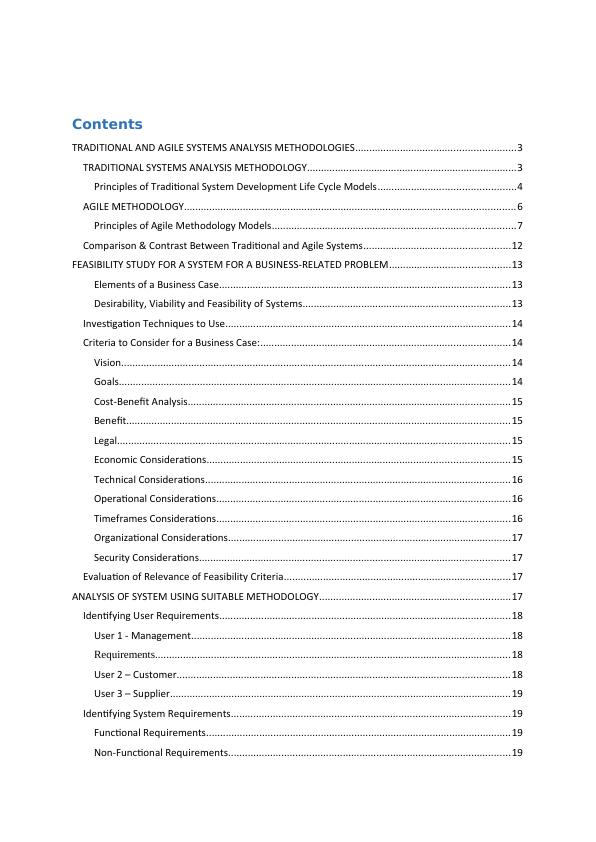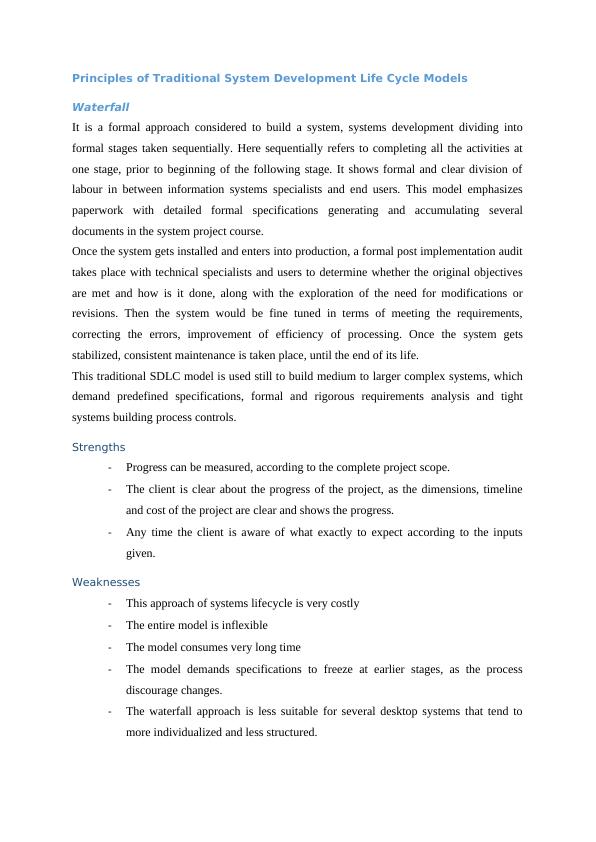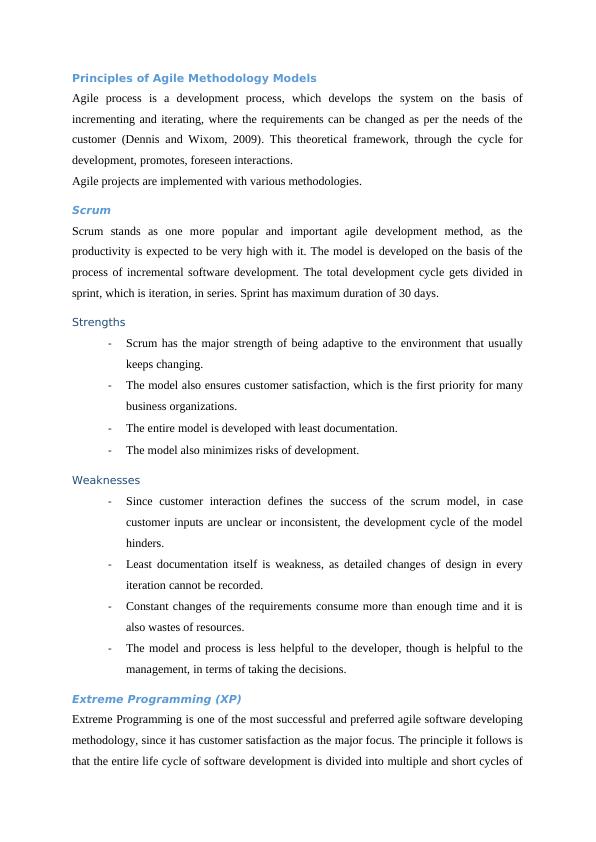Traditional and Agile Systems Analysis Methodologies
Added on 2023-01-16
46 Pages9856 Words22 Views
System Analysis and Design
Database
5/25/2019
Database
5/25/2019

Contents
TRADITIONAL AND AGILE SYSTEMS ANALYSIS METHODOLOGIES.........................................................3
TRADITIONAL SYSTEMS ANALYSIS METHODOLOGY...........................................................................3
Principles of Traditional System Development Life Cycle Models.................................................4
AGILE METHODOLOGY......................................................................................................................6
Principles of Agile Methodology Models.......................................................................................7
Comparison & Contrast Between Traditional and Agile Systems....................................................12
FEASIBILITY STUDY FOR A SYSTEM FOR A BUSINESS-RELATED PROBLEM...........................................13
Elements of a Business Case........................................................................................................13
Desirability, Viability and Feasibility of Systems..........................................................................13
Investigation Techniques to Use......................................................................................................14
Criteria to Consider for a Business Case:.........................................................................................14
Vision...........................................................................................................................................14
Goals............................................................................................................................................14
Cost-Benefit Analysis...................................................................................................................15
Benefit.........................................................................................................................................15
Legal............................................................................................................................................15
Economic Considerations............................................................................................................15
Technical Considerations.............................................................................................................16
Operational Considerations.........................................................................................................16
Timeframes Considerations.........................................................................................................16
Organizational Considerations.....................................................................................................17
Security Considerations...............................................................................................................17
Evaluation of Relevance of Feasibility Criteria.................................................................................17
ANALYSIS OF SYSTEM USING SUITABLE METHODOLOGY....................................................................17
Identifying User Requirements........................................................................................................18
User 1 - Management..................................................................................................................18
Requirements...............................................................................................................................18
User 2 – Customer.......................................................................................................................18
User 3 – Supplier..........................................................................................................................19
Identifying System Requirements....................................................................................................19
Functional Requirements.............................................................................................................19
Non-Functional Requirements.....................................................................................................19
TRADITIONAL AND AGILE SYSTEMS ANALYSIS METHODOLOGIES.........................................................3
TRADITIONAL SYSTEMS ANALYSIS METHODOLOGY...........................................................................3
Principles of Traditional System Development Life Cycle Models.................................................4
AGILE METHODOLOGY......................................................................................................................6
Principles of Agile Methodology Models.......................................................................................7
Comparison & Contrast Between Traditional and Agile Systems....................................................12
FEASIBILITY STUDY FOR A SYSTEM FOR A BUSINESS-RELATED PROBLEM...........................................13
Elements of a Business Case........................................................................................................13
Desirability, Viability and Feasibility of Systems..........................................................................13
Investigation Techniques to Use......................................................................................................14
Criteria to Consider for a Business Case:.........................................................................................14
Vision...........................................................................................................................................14
Goals............................................................................................................................................14
Cost-Benefit Analysis...................................................................................................................15
Benefit.........................................................................................................................................15
Legal............................................................................................................................................15
Economic Considerations............................................................................................................15
Technical Considerations.............................................................................................................16
Operational Considerations.........................................................................................................16
Timeframes Considerations.........................................................................................................16
Organizational Considerations.....................................................................................................17
Security Considerations...............................................................................................................17
Evaluation of Relevance of Feasibility Criteria.................................................................................17
ANALYSIS OF SYSTEM USING SUITABLE METHODOLOGY....................................................................17
Identifying User Requirements........................................................................................................18
User 1 - Management..................................................................................................................18
Requirements...............................................................................................................................18
User 2 – Customer.......................................................................................................................18
User 3 – Supplier..........................................................................................................................19
Identifying System Requirements....................................................................................................19
Functional Requirements.............................................................................................................19
Non-Functional Requirements.....................................................................................................19

Management Requirements........................................................................................................19
Customer Requirements..............................................................................................................20
Supplier Requirements................................................................................................................20
Identifying Constraints.....................................................................................................................20
Roles and Responsibilities............................................................................................................20
Sign off conditions Documentation and Determination..................................................................21
Documentation and Determination.............................................................................................21
Options to the Clint, Nina................................................................................................................22
Criteria to Use to Determine the Suitability of Methodology to Analyse the System......................22
Effectiveness of the analysis in the context of the methodology....................................................23
SYSTEM DESIGN ACCORDING TO USER REQUIREMENTS AND SYSTEM REQUIREMETNS.....................24
Project Plan and Design...................................................................................................................24
Project flow:................................................................................................................................25
Project Flow and Objectives........................................................................................................25
System Design and Document.........................................................................................................26
Interface Design...........................................................................................................................26
Database Design..........................................................................................................................40
Design Documentation....................................................................................................................41
Effectiveness of the System Design with Selected Methodology....................................................41
REFERENCES........................................................................................................................................42
TRADITIONAL AND AGILE SYSTEMS ANALYSIS
METHODOLOGIES
TRADITIONAL SYSTEMS ANALYSIS METHODOLOGY
The traditional software development life cycle has been almost obsolete i
The typical traditional systems lifecycle has become oldest method for information systems
building. However, the same has been in use even today in the projects, medium to larger
complex systems.
Customer Requirements..............................................................................................................20
Supplier Requirements................................................................................................................20
Identifying Constraints.....................................................................................................................20
Roles and Responsibilities............................................................................................................20
Sign off conditions Documentation and Determination..................................................................21
Documentation and Determination.............................................................................................21
Options to the Clint, Nina................................................................................................................22
Criteria to Use to Determine the Suitability of Methodology to Analyse the System......................22
Effectiveness of the analysis in the context of the methodology....................................................23
SYSTEM DESIGN ACCORDING TO USER REQUIREMENTS AND SYSTEM REQUIREMETNS.....................24
Project Plan and Design...................................................................................................................24
Project flow:................................................................................................................................25
Project Flow and Objectives........................................................................................................25
System Design and Document.........................................................................................................26
Interface Design...........................................................................................................................26
Database Design..........................................................................................................................40
Design Documentation....................................................................................................................41
Effectiveness of the System Design with Selected Methodology....................................................41
REFERENCES........................................................................................................................................42
TRADITIONAL AND AGILE SYSTEMS ANALYSIS
METHODOLOGIES
TRADITIONAL SYSTEMS ANALYSIS METHODOLOGY
The traditional software development life cycle has been almost obsolete i
The typical traditional systems lifecycle has become oldest method for information systems
building. However, the same has been in use even today in the projects, medium to larger
complex systems.

Principles of Traditional System Development Life Cycle Models
Waterfall
It is a formal approach considered to build a system, systems development dividing into
formal stages taken sequentially. Here sequentially refers to completing all the activities at
one stage, prior to beginning of the following stage. It shows formal and clear division of
labour in between information systems specialists and end users. This model emphasizes
paperwork with detailed formal specifications generating and accumulating several
documents in the system project course.
Once the system gets installed and enters into production, a formal post implementation audit
takes place with technical specialists and users to determine whether the original objectives
are met and how is it done, along with the exploration of the need for modifications or
revisions. Then the system would be fine tuned in terms of meeting the requirements,
correcting the errors, improvement of efficiency of processing. Once the system gets
stabilized, consistent maintenance is taken place, until the end of its life.
This traditional SDLC model is used still to build medium to larger complex systems, which
demand predefined specifications, formal and rigorous requirements analysis and tight
systems building process controls.
Strengths
- Progress can be measured, according to the complete project scope.
- The client is clear about the progress of the project, as the dimensions, timeline
and cost of the project are clear and shows the progress.
- Any time the client is aware of what exactly to expect according to the inputs
given.
Weaknesses
- This approach of systems lifecycle is very costly
- The entire model is inflexible
- The model consumes very long time
- The model demands specifications to freeze at earlier stages, as the process
discourage changes.
- The waterfall approach is less suitable for several desktop systems that tend to
more individualized and less structured.
Waterfall
It is a formal approach considered to build a system, systems development dividing into
formal stages taken sequentially. Here sequentially refers to completing all the activities at
one stage, prior to beginning of the following stage. It shows formal and clear division of
labour in between information systems specialists and end users. This model emphasizes
paperwork with detailed formal specifications generating and accumulating several
documents in the system project course.
Once the system gets installed and enters into production, a formal post implementation audit
takes place with technical specialists and users to determine whether the original objectives
are met and how is it done, along with the exploration of the need for modifications or
revisions. Then the system would be fine tuned in terms of meeting the requirements,
correcting the errors, improvement of efficiency of processing. Once the system gets
stabilized, consistent maintenance is taken place, until the end of its life.
This traditional SDLC model is used still to build medium to larger complex systems, which
demand predefined specifications, formal and rigorous requirements analysis and tight
systems building process controls.
Strengths
- Progress can be measured, according to the complete project scope.
- The client is clear about the progress of the project, as the dimensions, timeline
and cost of the project are clear and shows the progress.
- Any time the client is aware of what exactly to expect according to the inputs
given.
Weaknesses
- This approach of systems lifecycle is very costly
- The entire model is inflexible
- The model consumes very long time
- The model demands specifications to freeze at earlier stages, as the process
discourage changes.
- The waterfall approach is less suitable for several desktop systems that tend to
more individualized and less structured.

Prototyping
The prototyping model involves an experimental system building inexpensively and rapidly
to evaluate for end users. Users can refine and better tune the information requirements by
interacting with the prototype. The users can endorse prototype as a template for final system
creation.
The prototype is meant and considered as only a preliminary model, though it stands as a
working version of part of the system or information system. After the prototype becomes
operational it is still refined further until user requirements are confirmed precisely. After
finalizing the design, the prototype is transitioned to a refined and polished production
system.
The model involves iterative process for development of the system. Planned iterations
replace unplanned rework in prototyping, with each version reflecting the requirements of the
users, more accurately.
Strengths
- Prototyping has the capability to build the system, even there is any uncertainty
regarding designs solutions or requirements.
- The model has the capability to produce the systems fulfilling the requirements of
the user.
Weaknesses
- Prototyping may not accommodate data in larger quantities easily in a production
environment, in case of hastily constructed systems, especially.
- Forecasting the total project duration and completion project date is troublesome.
Spiral
Spiral methodology reflects the tasks relationship with increased parallelism, concurrency in
the activities of design and build and rapid prototyping. And it allows planning methodically,
identifying tasks and deliverables for each of the step in the model. Actually, Spiral
methodology has been developed to fix the drawbacks associated with the Waterfall
methodology.
The Spiral methodology can perceive development process as ‘peeling the onion’, more
likely as progressing through layers. The phase processes and phases are linear, though its
prototype allows the users to find whether the project is moving on track, should be ended or
sent to previous phase.
The prototyping model involves an experimental system building inexpensively and rapidly
to evaluate for end users. Users can refine and better tune the information requirements by
interacting with the prototype. The users can endorse prototype as a template for final system
creation.
The prototype is meant and considered as only a preliminary model, though it stands as a
working version of part of the system or information system. After the prototype becomes
operational it is still refined further until user requirements are confirmed precisely. After
finalizing the design, the prototype is transitioned to a refined and polished production
system.
The model involves iterative process for development of the system. Planned iterations
replace unplanned rework in prototyping, with each version reflecting the requirements of the
users, more accurately.
Strengths
- Prototyping has the capability to build the system, even there is any uncertainty
regarding designs solutions or requirements.
- The model has the capability to produce the systems fulfilling the requirements of
the user.
Weaknesses
- Prototyping may not accommodate data in larger quantities easily in a production
environment, in case of hastily constructed systems, especially.
- Forecasting the total project duration and completion project date is troublesome.
Spiral
Spiral methodology reflects the tasks relationship with increased parallelism, concurrency in
the activities of design and build and rapid prototyping. And it allows planning methodically,
identifying tasks and deliverables for each of the step in the model. Actually, Spiral
methodology has been developed to fix the drawbacks associated with the Waterfall
methodology.
The Spiral methodology can perceive development process as ‘peeling the onion’, more
likely as progressing through layers. The phase processes and phases are linear, though its
prototype allows the users to find whether the project is moving on track, should be ended or
sent to previous phase.

The Spiral methodology starts in the central part of the spiral. One completed cycle shows a
single stage of process. The product keeps matured, as the spiral progresses.
Strengths
- The Spiral methodology has the ability to apply to development and maintenance
as well.
- At any stage, it can incorporate with prototyping as an option to reduce reduction
at any of the stages.
- The methodology allows focusing on the existing software reuse.
- It allows going back to the previous stages and also accommodates reworks.
- It allows focusing on eliminating or removing unattractive alternatives and errors
at earlier stages.
Weaknesses
- The methodology relies more on risk assessment expertise of the project
professionals.
- It is less effective to work optimally with contracts of fixed price.
- Even for general use, it demands refinement.
- It demands the management to be more wary in terms of control.
- It is less effective and difficult to be used by systems integrators and outside
contractors.
AGILE METHODOLOGY
Agile methodology is preferred and implemented by several business organizations. The agile
methodology follows the following key concepts.
(Ambler and Lines, 2012)
- User stories
- Incremental development
- Daily meeting
- Team active involvement
- Iterative development
- Milestone retrospection
- Personas
single stage of process. The product keeps matured, as the spiral progresses.
Strengths
- The Spiral methodology has the ability to apply to development and maintenance
as well.
- At any stage, it can incorporate with prototyping as an option to reduce reduction
at any of the stages.
- The methodology allows focusing on the existing software reuse.
- It allows going back to the previous stages and also accommodates reworks.
- It allows focusing on eliminating or removing unattractive alternatives and errors
at earlier stages.
Weaknesses
- The methodology relies more on risk assessment expertise of the project
professionals.
- It is less effective to work optimally with contracts of fixed price.
- Even for general use, it demands refinement.
- It demands the management to be more wary in terms of control.
- It is less effective and difficult to be used by systems integrators and outside
contractors.
AGILE METHODOLOGY
Agile methodology is preferred and implemented by several business organizations. The agile
methodology follows the following key concepts.
(Ambler and Lines, 2012)
- User stories
- Incremental development
- Daily meeting
- Team active involvement
- Iterative development
- Milestone retrospection
- Personas

Principles of Agile Methodology Models
Agile process is a development process, which develops the system on the basis of
incrementing and iterating, where the requirements can be changed as per the needs of the
customer (Dennis and Wixom, 2009). This theoretical framework, through the cycle for
development, promotes, foreseen interactions.
Agile projects are implemented with various methodologies.
Scrum
Scrum stands as one more popular and important agile development method, as the
productivity is expected to be very high with it. The model is developed on the basis of the
process of incremental software development. The total development cycle gets divided in
sprint, which is iteration, in series. Sprint has maximum duration of 30 days.
Strengths
- Scrum has the major strength of being adaptive to the environment that usually
keeps changing.
- The model also ensures customer satisfaction, which is the first priority for many
business organizations.
- The entire model is developed with least documentation.
- The model also minimizes risks of development.
Weaknesses
- Since customer interaction defines the success of the scrum model, in case
customer inputs are unclear or inconsistent, the development cycle of the model
hinders.
- Least documentation itself is weakness, as detailed changes of design in every
iteration cannot be recorded.
- Constant changes of the requirements consume more than enough time and it is
also wastes of resources.
- The model and process is less helpful to the developer, though is helpful to the
management, in terms of taking the decisions.
Extreme Programming (XP)
Extreme Programming is one of the most successful and preferred agile software developing
methodology, since it has customer satisfaction as the major focus. The principle it follows is
that the entire life cycle of software development is divided into multiple and short cycles of
Agile process is a development process, which develops the system on the basis of
incrementing and iterating, where the requirements can be changed as per the needs of the
customer (Dennis and Wixom, 2009). This theoretical framework, through the cycle for
development, promotes, foreseen interactions.
Agile projects are implemented with various methodologies.
Scrum
Scrum stands as one more popular and important agile development method, as the
productivity is expected to be very high with it. The model is developed on the basis of the
process of incremental software development. The total development cycle gets divided in
sprint, which is iteration, in series. Sprint has maximum duration of 30 days.
Strengths
- Scrum has the major strength of being adaptive to the environment that usually
keeps changing.
- The model also ensures customer satisfaction, which is the first priority for many
business organizations.
- The entire model is developed with least documentation.
- The model also minimizes risks of development.
Weaknesses
- Since customer interaction defines the success of the scrum model, in case
customer inputs are unclear or inconsistent, the development cycle of the model
hinders.
- Least documentation itself is weakness, as detailed changes of design in every
iteration cannot be recorded.
- Constant changes of the requirements consume more than enough time and it is
also wastes of resources.
- The model and process is less helpful to the developer, though is helpful to the
management, in terms of taking the decisions.
Extreme Programming (XP)
Extreme Programming is one of the most successful and preferred agile software developing
methodology, since it has customer satisfaction as the major focus. The principle it follows is
that the entire life cycle of software development is divided into multiple and short cycles of

development (Dan et al., 2014). At any phase of this cycle, it incorporates and welcomes
requirements or changes proposed by the customers.
XP follows simple values, such as courage, feedback, communication and simplicity.
Strengths
- XP enables the process to quick and high-quality delivery of the outcomes
- The delivery of the outcomes are continous.
- The model allows best outcome, as customer involvement is high and because of
rapid feedback loops, close teamwork with coninous planning.
Weaknesses
- It demands more training and talent.
- Organizational transformation to this model from an existing traditional SDLC
model needs structural transformation.
- Scalability is a troublesome, unless specific models are followed.
Lean
Lean methodology offers the features of solid conceptual principles, values and frameworks,
along with fair practices. This methodology works basically on reducing the waste .
The methodology involves the process that is divided into three activities value-adding, non-
value adding and essential non-value adding (Ladas & Corey, 2007). Here, the activities
involved in the activity called non-value adding is considered to be waste and so these
activities are tried to remove, considering it as waste, so that the entire model is made as
leaner. Hence delivery becomes faster with lesser wasted efforts.
Strengths
- Improved efficiency in the process of development, because of elimination of the
waste.
- The same also speeds up the software development process, which in turn reduces
cost and time of the project.
- Faster product delivery, which means delivery of more productivity earlier.
- Development team empowerment helps to develop the team’s ability of decision
making, which would also motivate the team.
requirements or changes proposed by the customers.
XP follows simple values, such as courage, feedback, communication and simplicity.
Strengths
- XP enables the process to quick and high-quality delivery of the outcomes
- The delivery of the outcomes are continous.
- The model allows best outcome, as customer involvement is high and because of
rapid feedback loops, close teamwork with coninous planning.
Weaknesses
- It demands more training and talent.
- Organizational transformation to this model from an existing traditional SDLC
model needs structural transformation.
- Scalability is a troublesome, unless specific models are followed.
Lean
Lean methodology offers the features of solid conceptual principles, values and frameworks,
along with fair practices. This methodology works basically on reducing the waste .
The methodology involves the process that is divided into three activities value-adding, non-
value adding and essential non-value adding (Ladas & Corey, 2007). Here, the activities
involved in the activity called non-value adding is considered to be waste and so these
activities are tried to remove, considering it as waste, so that the entire model is made as
leaner. Hence delivery becomes faster with lesser wasted efforts.
Strengths
- Improved efficiency in the process of development, because of elimination of the
waste.
- The same also speeds up the software development process, which in turn reduces
cost and time of the project.
- Faster product delivery, which means delivery of more productivity earlier.
- Development team empowerment helps to develop the team’s ability of decision
making, which would also motivate the team.

End of preview
Want to access all the pages? Upload your documents or become a member.
Related Documents
Project Management Plan for Hybrid System Implementationlg...
|20
|4113
|88
System Analysis & Design for Swinburne Gurulg...
|18
|3858
|121
Fuellies - Project Managementlg...
|11
|1693
|71
Unit: 34 system analysis and designlg...
|30
|7744
|230
Systems Analysis & Design | Assignmentlg...
|18
|4366
|34
System Analysis & Design : Software Development Life Cyclelg...
|46
|10454
|242
